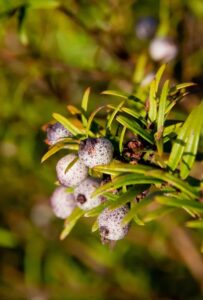
Midyim – the Australian Berry
By Clive Larkman
As a child, I remember blackberries, strawberries and occasionally raspberries. As time moved on, we started to get many other berries like boysenberries, mulberries, youngberries and our own local silvan berry. We then became really modern with blueberries, cranberries, and red and black currants to really challenge our taste buds. Now, in 2020s, we are becoming even more exotic. Some of the new berries to hit the Australian market include yumberry, haskap berry, jujube berry.
The ‘new’ refers to entering the Australian fresh food market. Nearly all the above berries have been around for decades if not centuries. The other issue is, of course, cultivars. As we are experimenting with new berries, the farmers are experimenting with breeding to create new crosses and to develop new cultivars. The new cultivars are impressive, with many based on flavour, but many are also based on selections for disease resistance, fruiting time, fruiting zones and climatic tolerance.
The berry market is huge with good profits to be made but also large sums to be lost. Weather can play havoc on harvest times and yields. With the predicted changes in our environment due to climate change, our farmers are fighting to remain viable in both the short and long term. The climate affects the berry farms from all sides. Some berries are drought tolerant, others are frost-hardy, and others are okay with a range of environmental changes. The next issue is less obvious. Is the berry effected by daylength, vernalisation, maximum/minimum temperatures and so on. Changing weather patterns will change these criteria so that some farms will have to change their crops.
One solution is to grow fruit that is indigenous to the local area as it is more likely to be tolerant of the local weather extremes. It also has a better chance of adapting as the weather changes. One such plant is Midyim Berry (Austromyrtus dulcis) that is native to SE Queensland and NE NSW. It grows as an understory plant of coastal and near-coastal woodlands. It prefers growing on sandy soils but can also be found on the margins of rainforests. It is a small spreading shrub growing from 75 to 150cm high and 80 to 200cm wide. It has small white flowers from mid-spring to early summer. These produce lots of sweet, edible berries which ripen in summer and autumn. The fruit is white with purple spots and is both sweet and slightly sour, somewhat like blueberries. The fruit, like most berries, can be eaten fresh, with cream or used for baking and making jams and jellies.
The plant is a member of the Myrtaceae family, so it is susceptible to Myrtle Rust, although it is not known to be commonly damaged by the disease. It is basically free from most other pests and diseases. It is quite an attractive ‘edimental’ that looks good growing by itself or planted as an informal hedge. Like most other Myrtles, it is easy to prune and keep to whatever size or shape is needed. It would be an excellent small hedge for a parterre garden. The Midyim Berry (Midgen Berry, Silk Myrtle) will grow well in large pots and, as such, is suitable for a nice light verandah or inner city terrace.
There are lots of great drinks made with various berry syrups. I think that a simple syrup can be made with Midyim berries, sugar and warm water. Mix the three together then simmer gently for about 10 to 15 minutes. Remove the solids, add a splash of lemon juice and then cool. Use the syrup to make a great Midyim Gin Fizz Cocktail. Combine a good gin, a shot of lime juice, and 40ml of the syrup in a cocktail shaker. Fill with ice and shake until completely chilled. Serve with a sprig of mint or lemon verbena (Aloysia triphylla).
